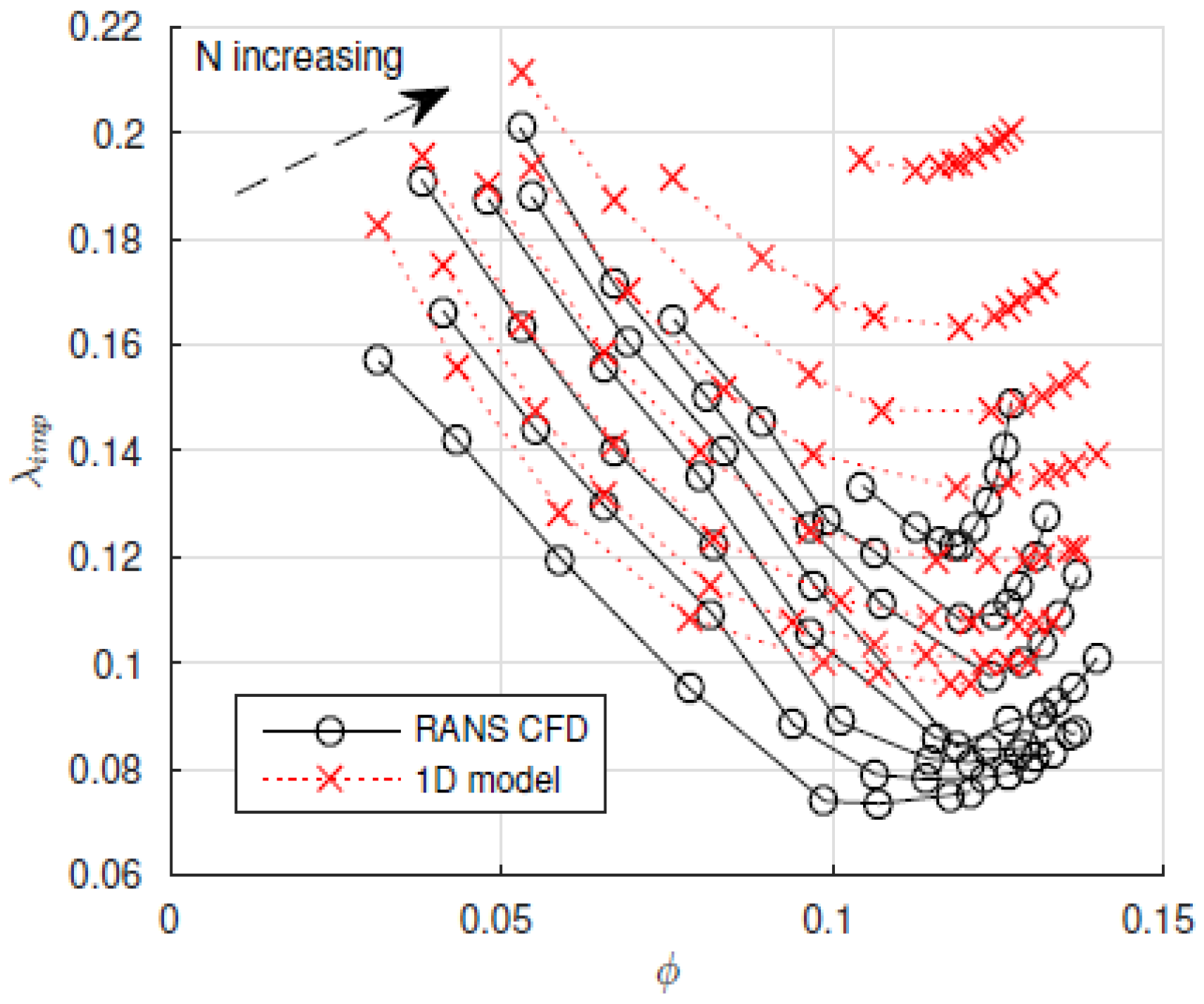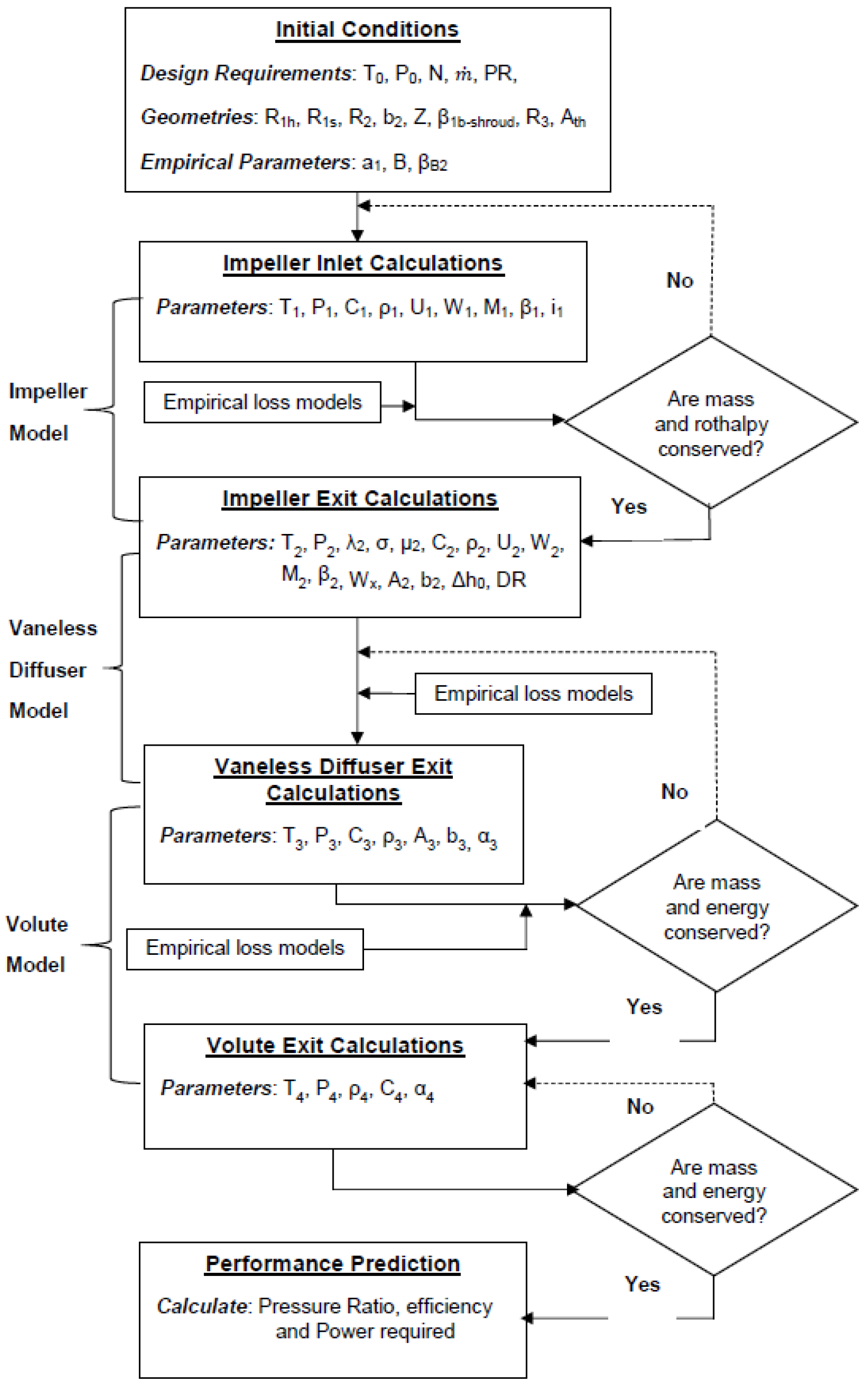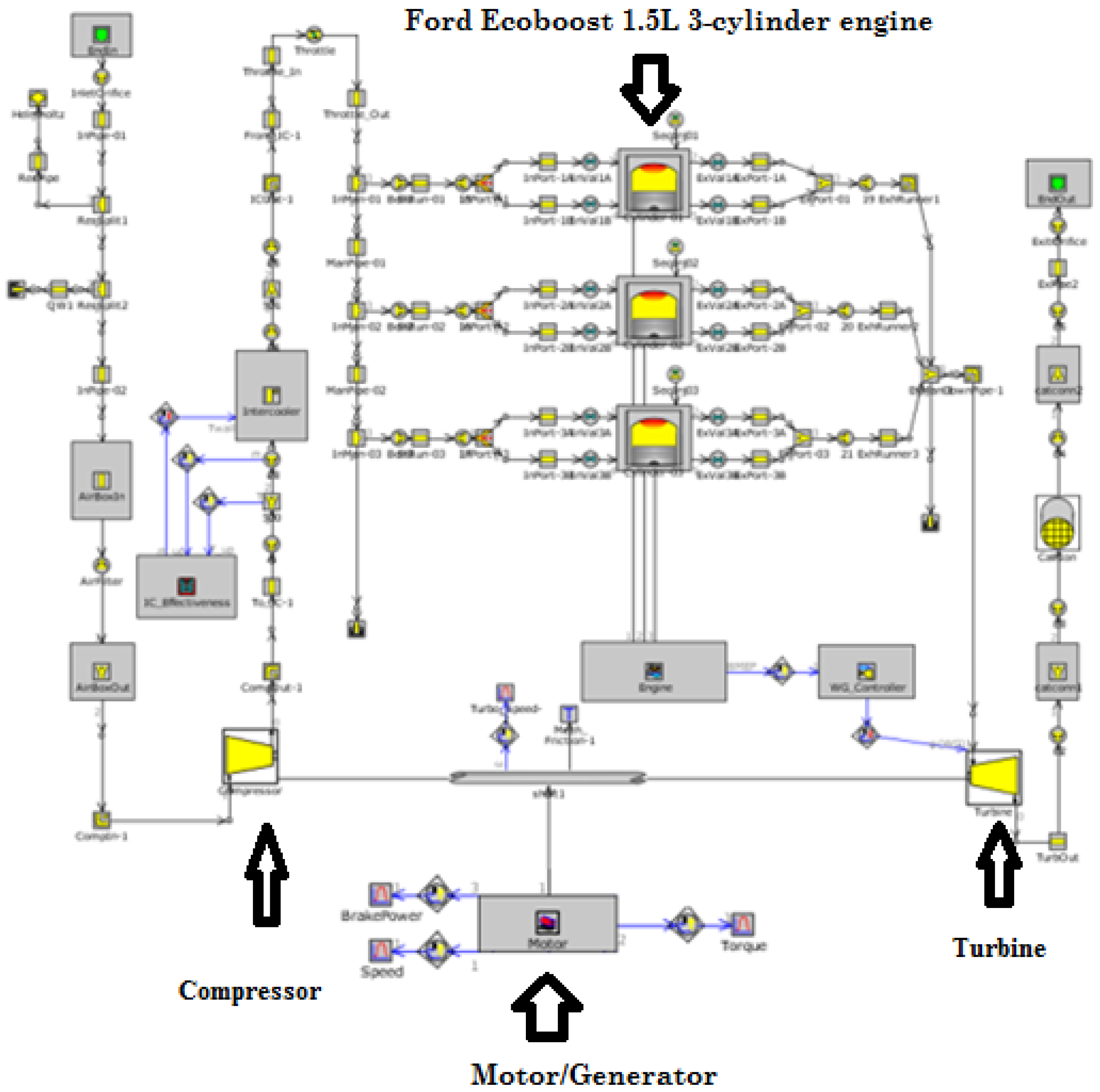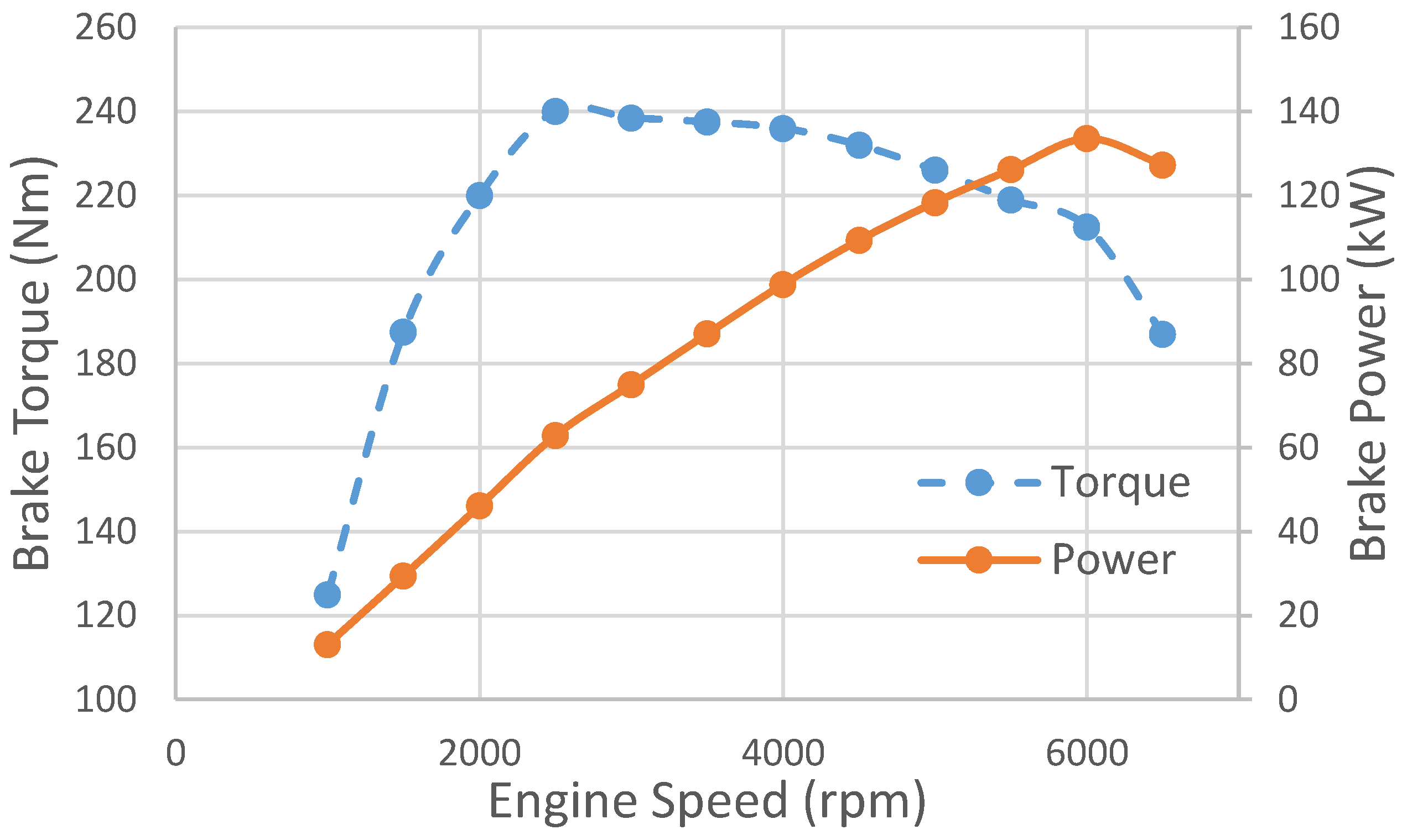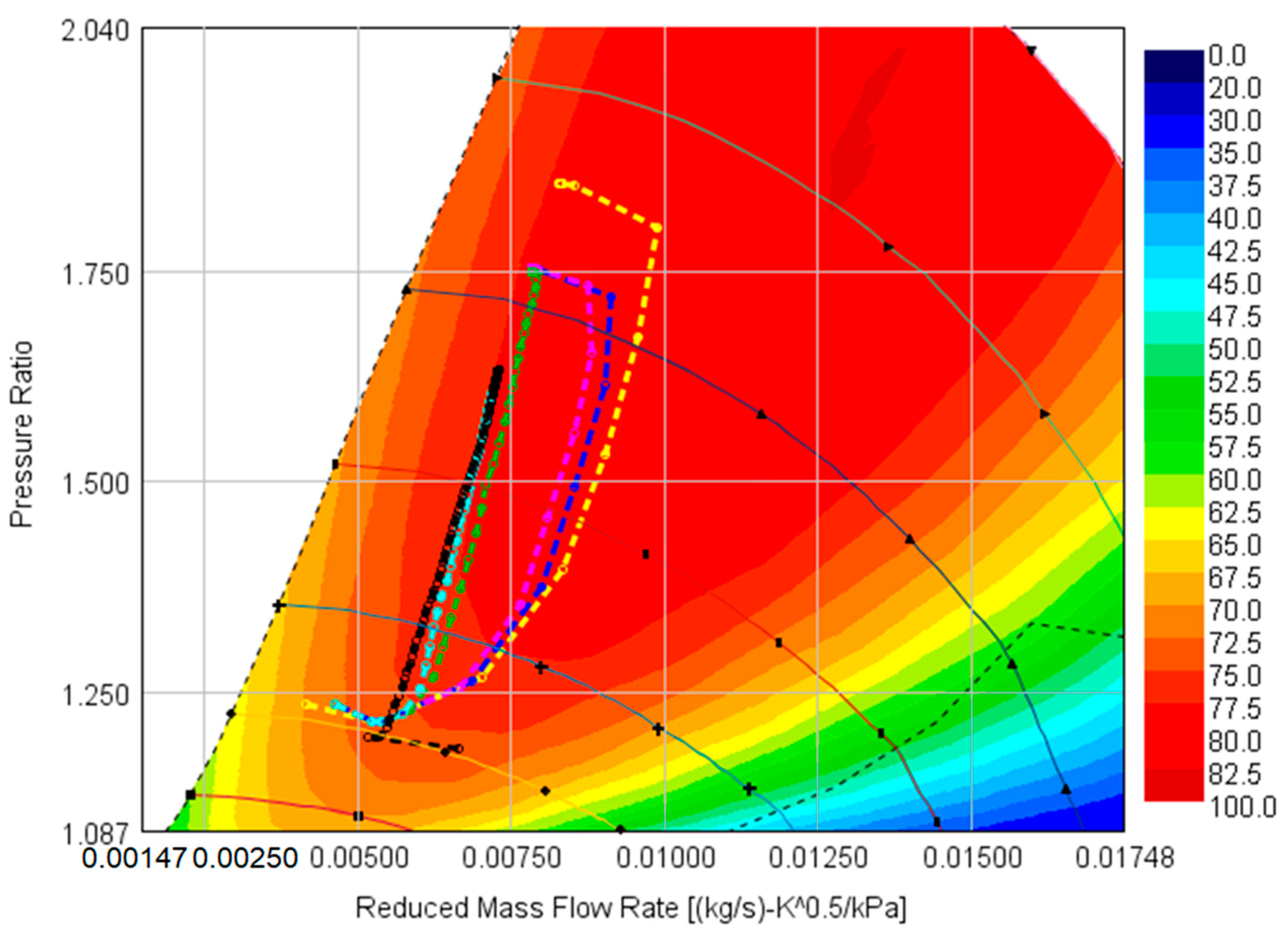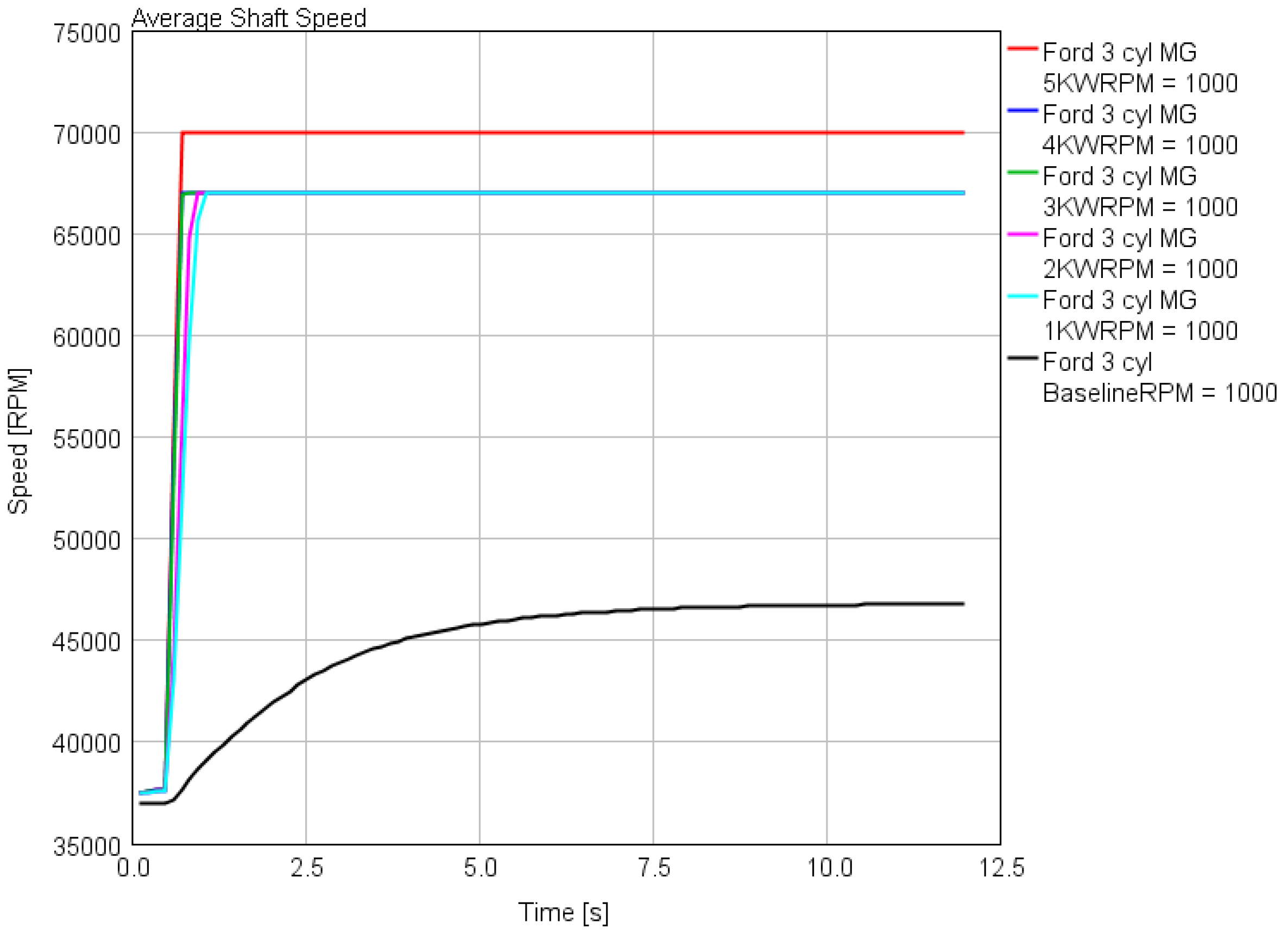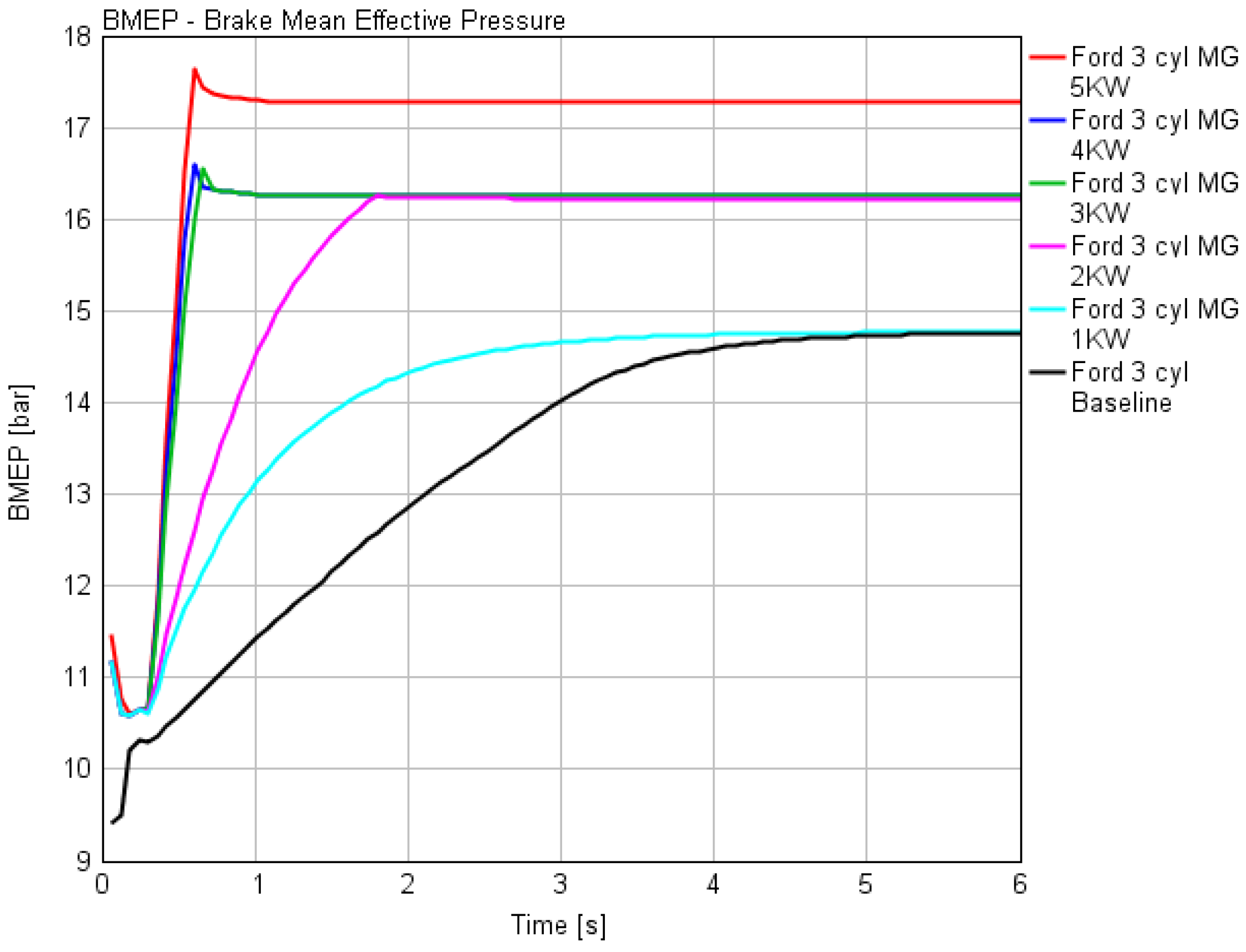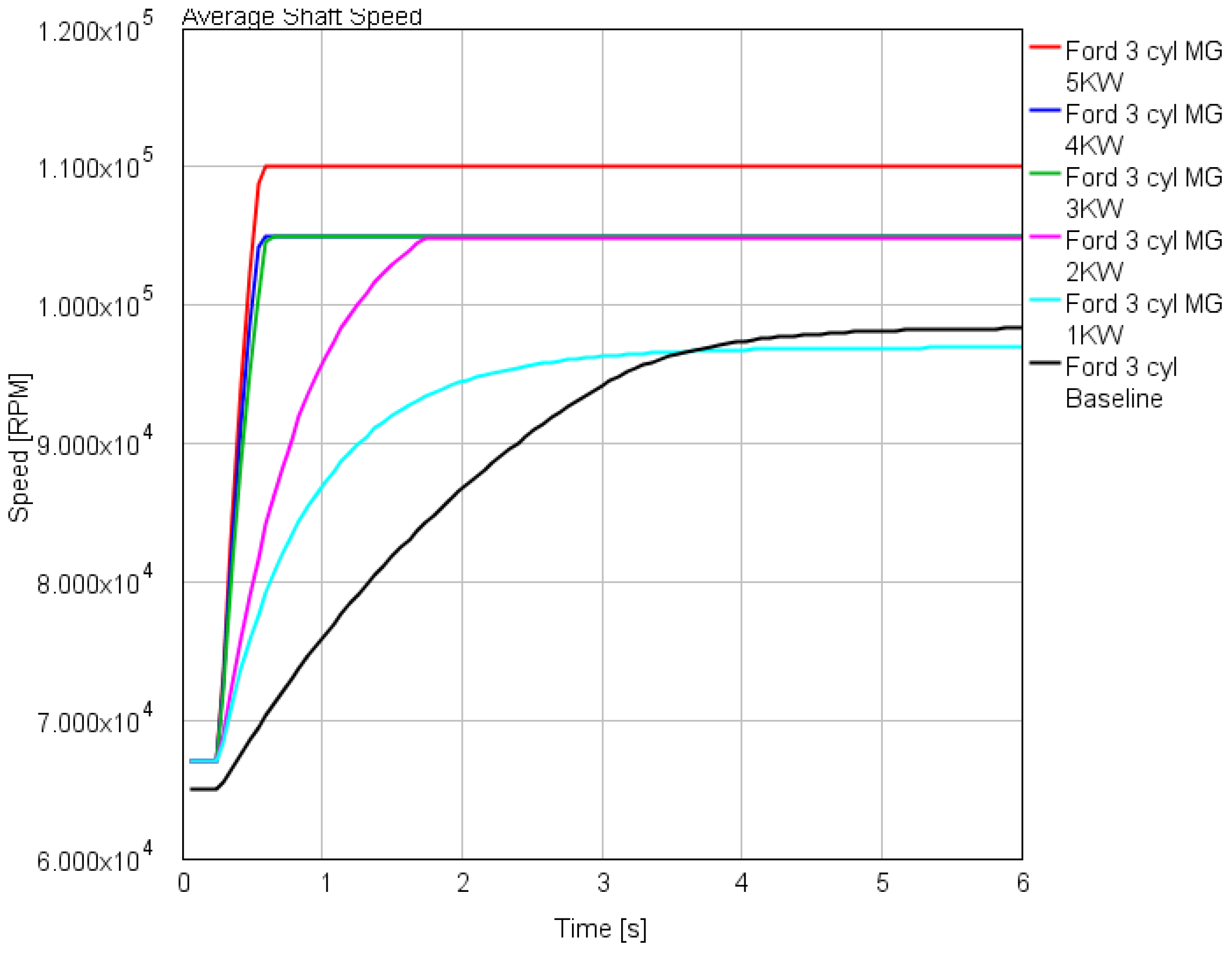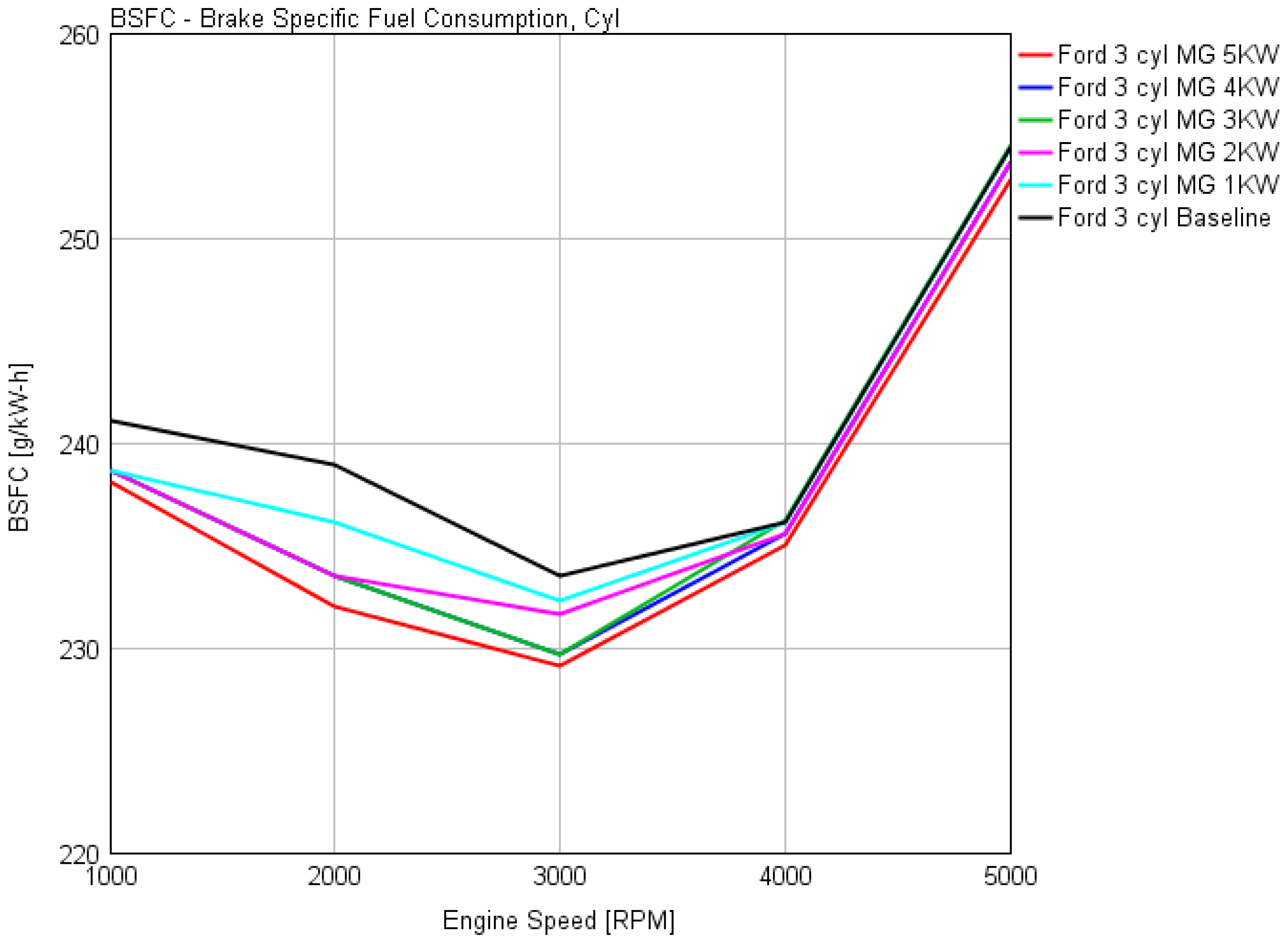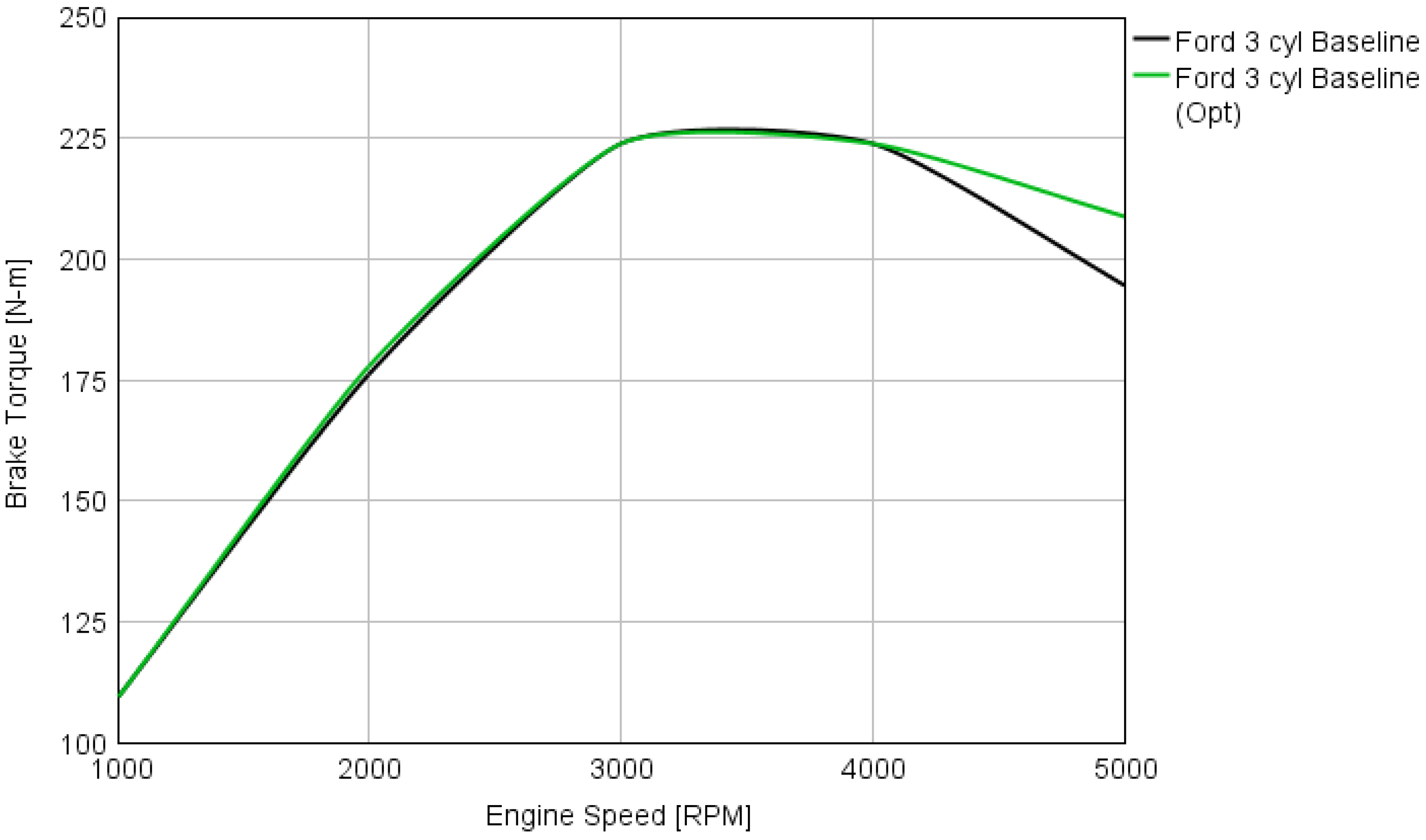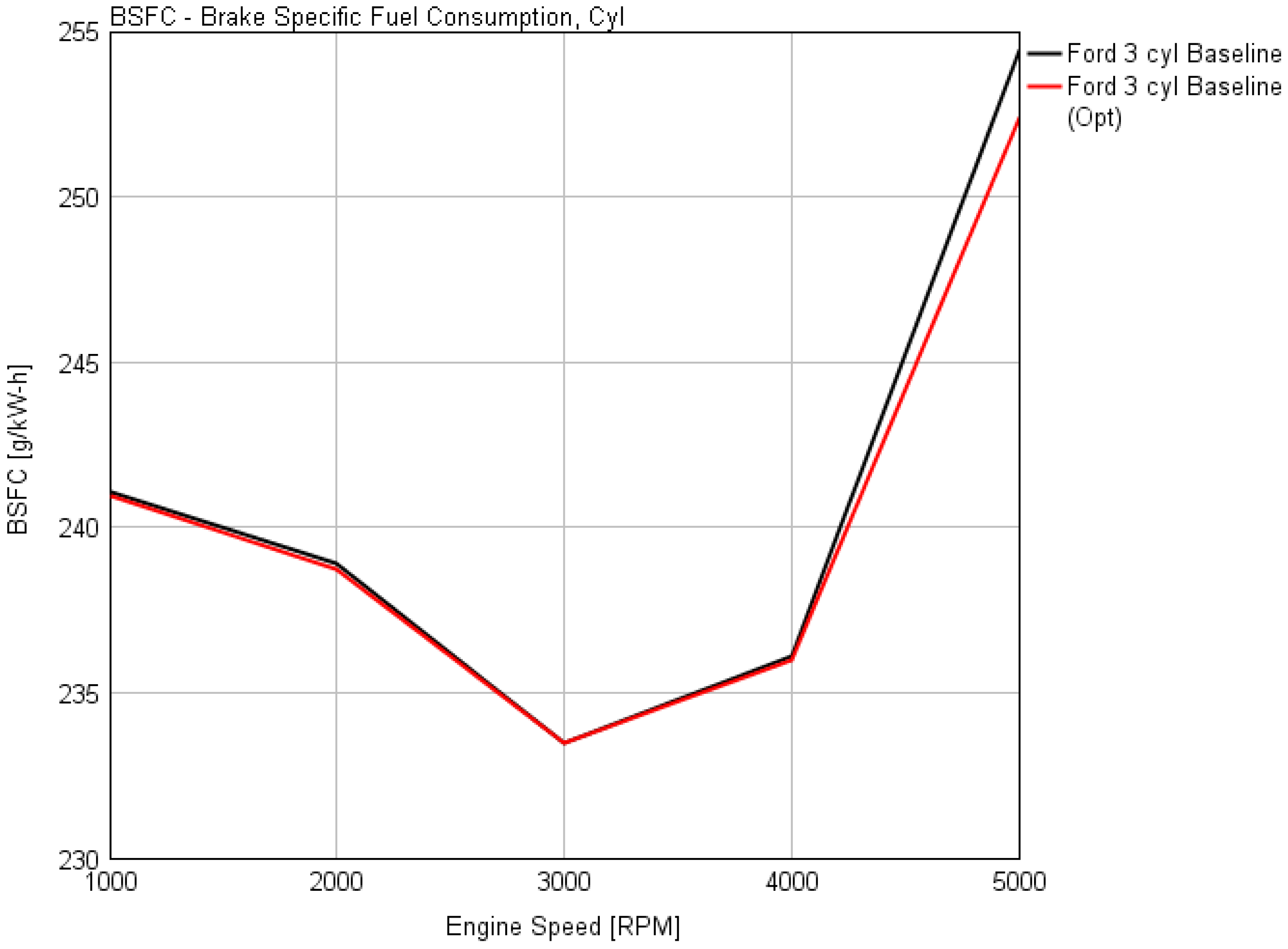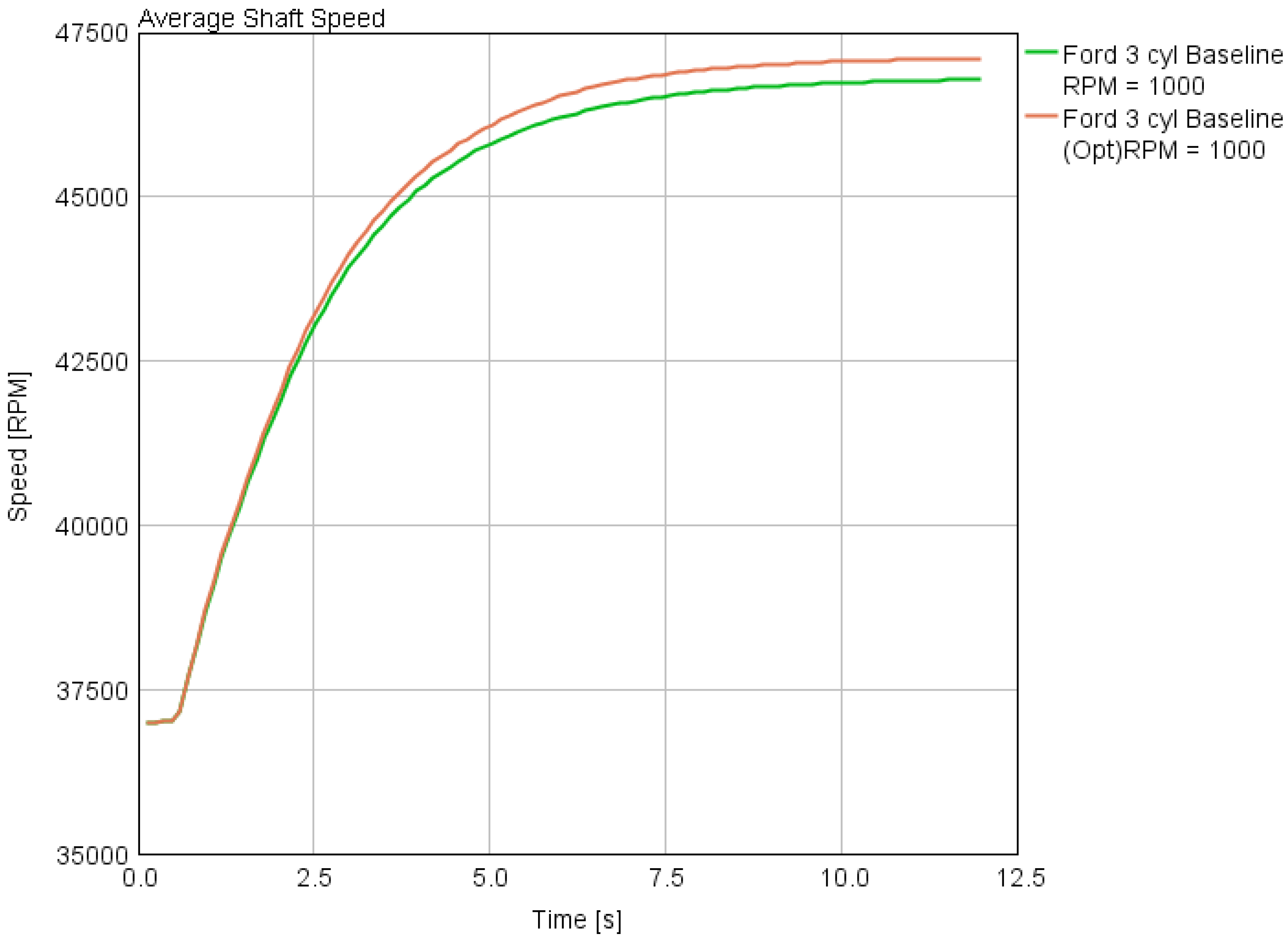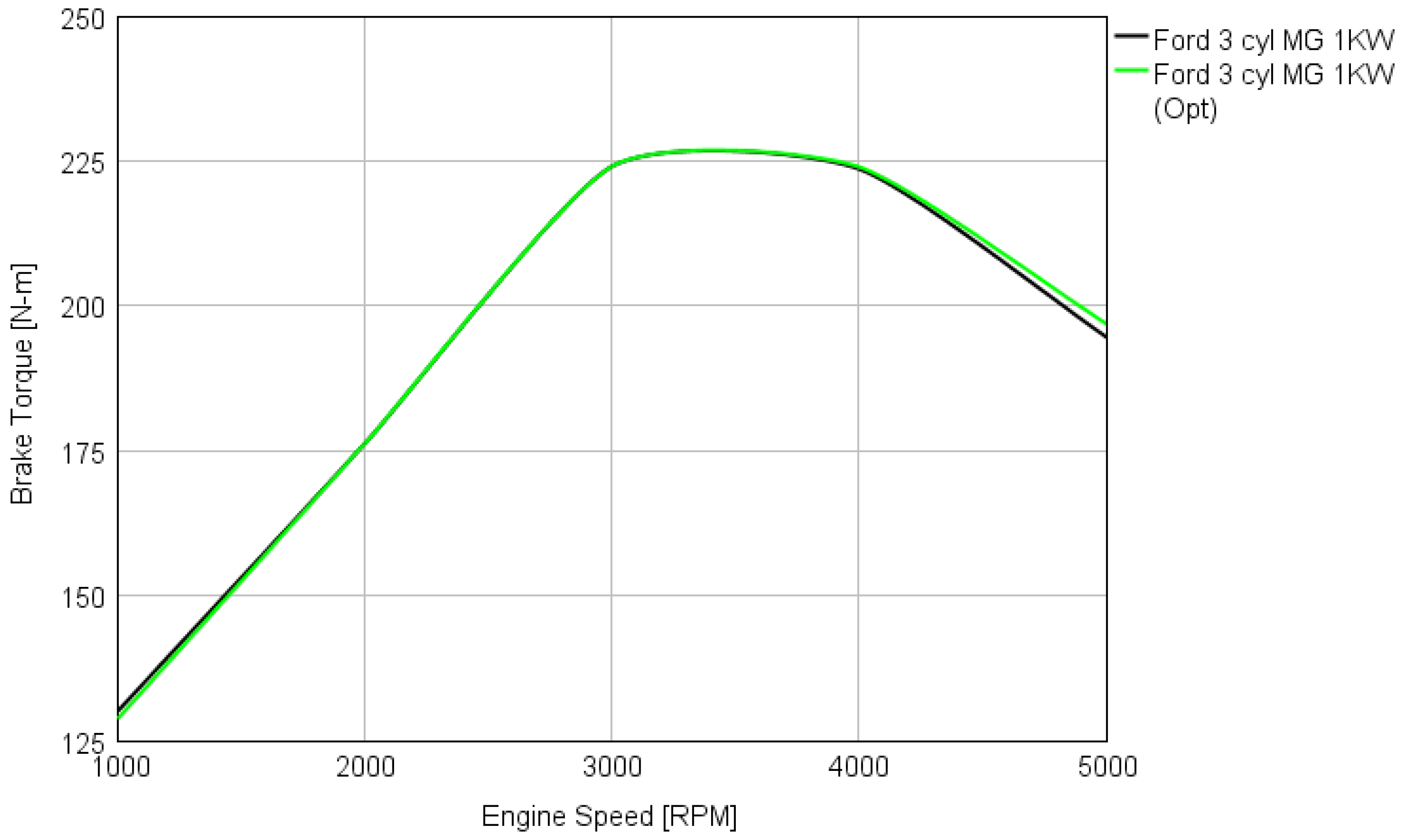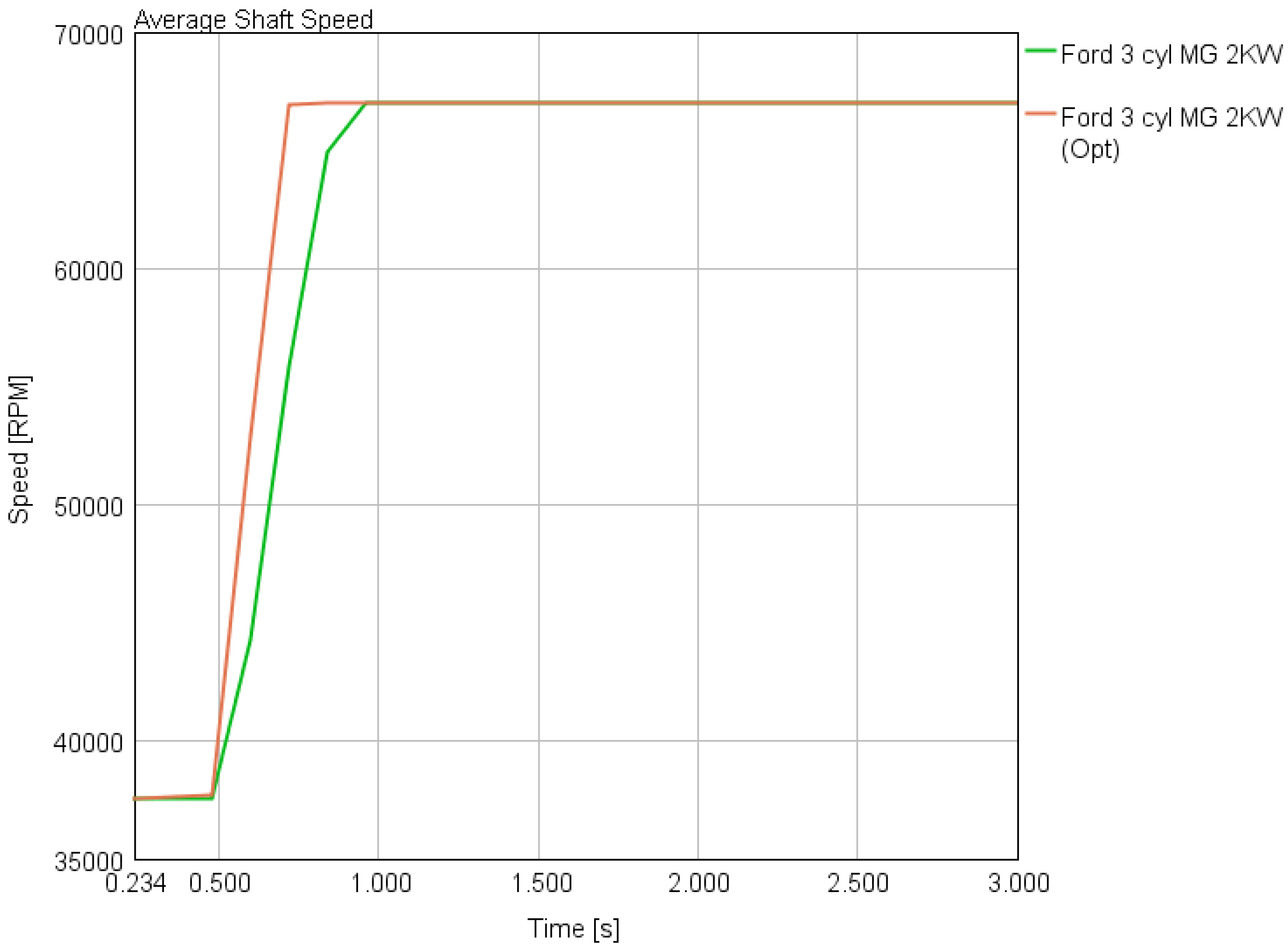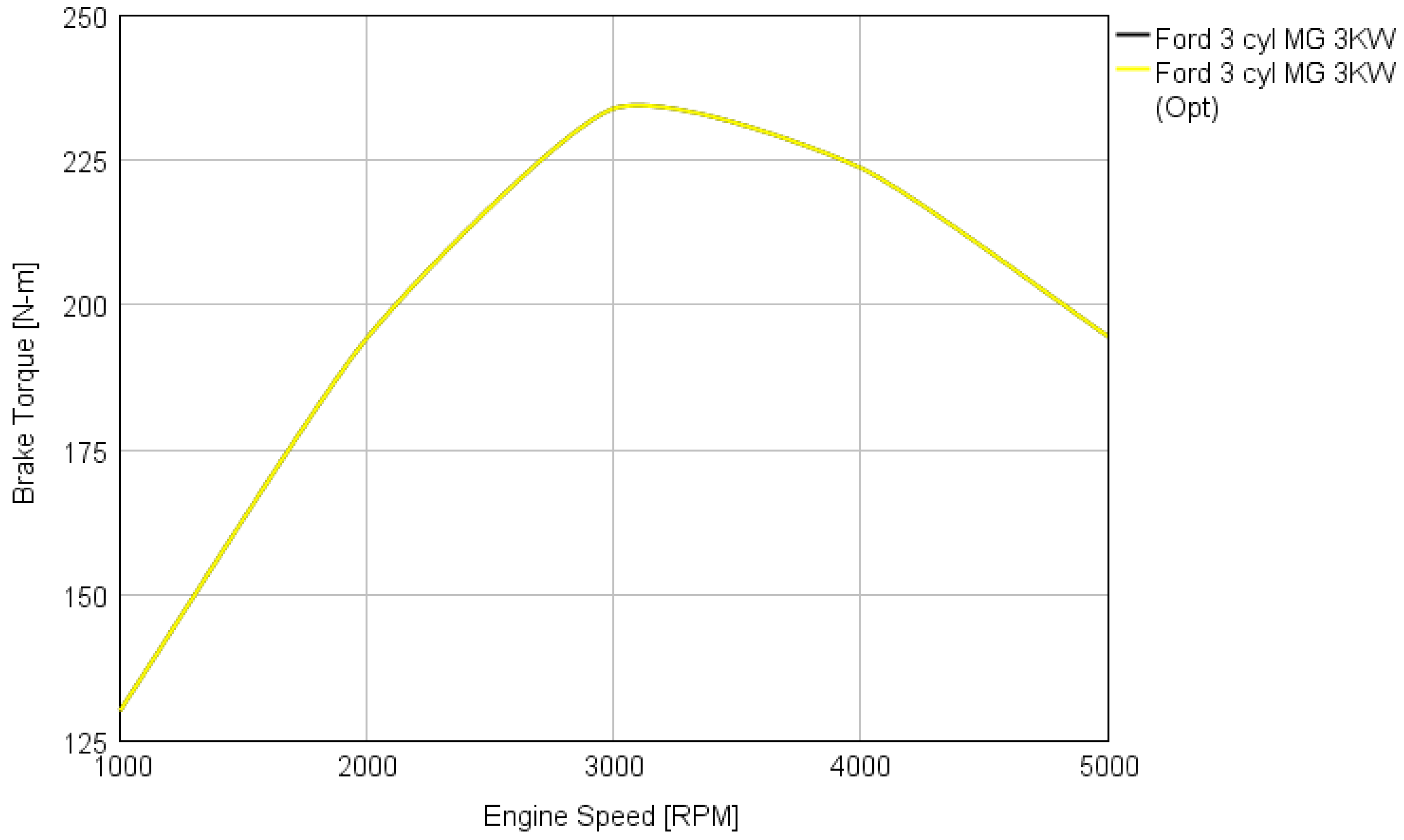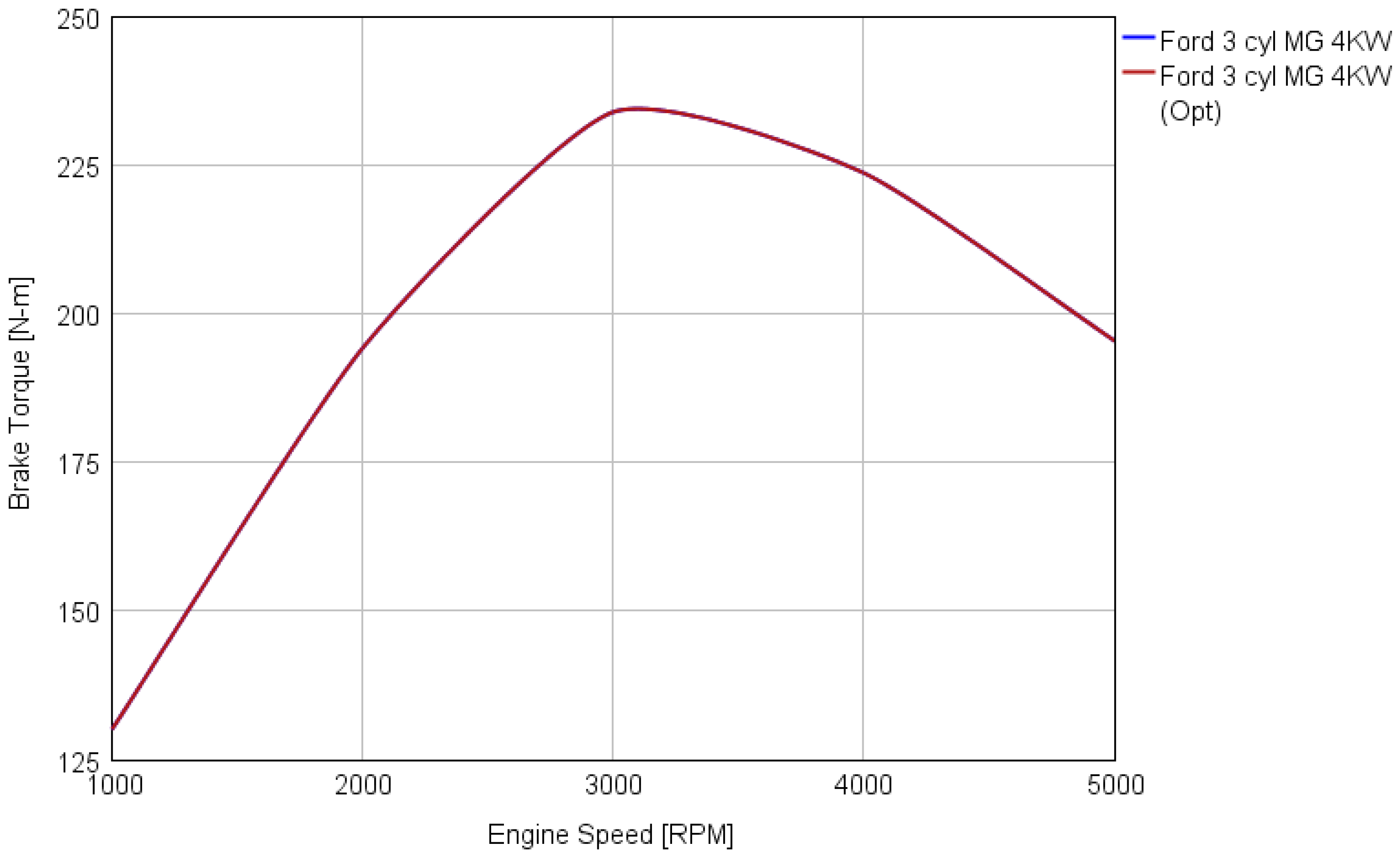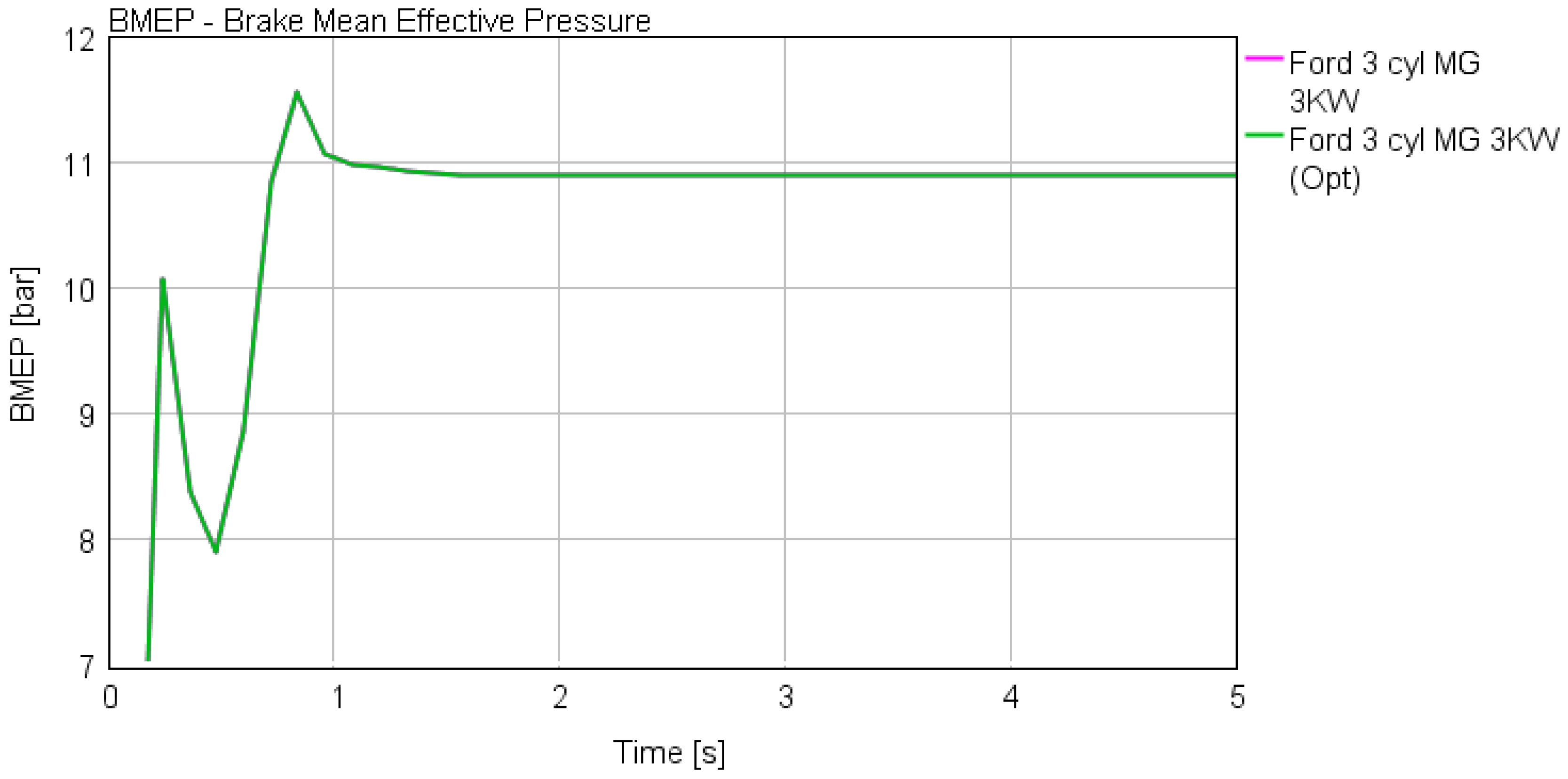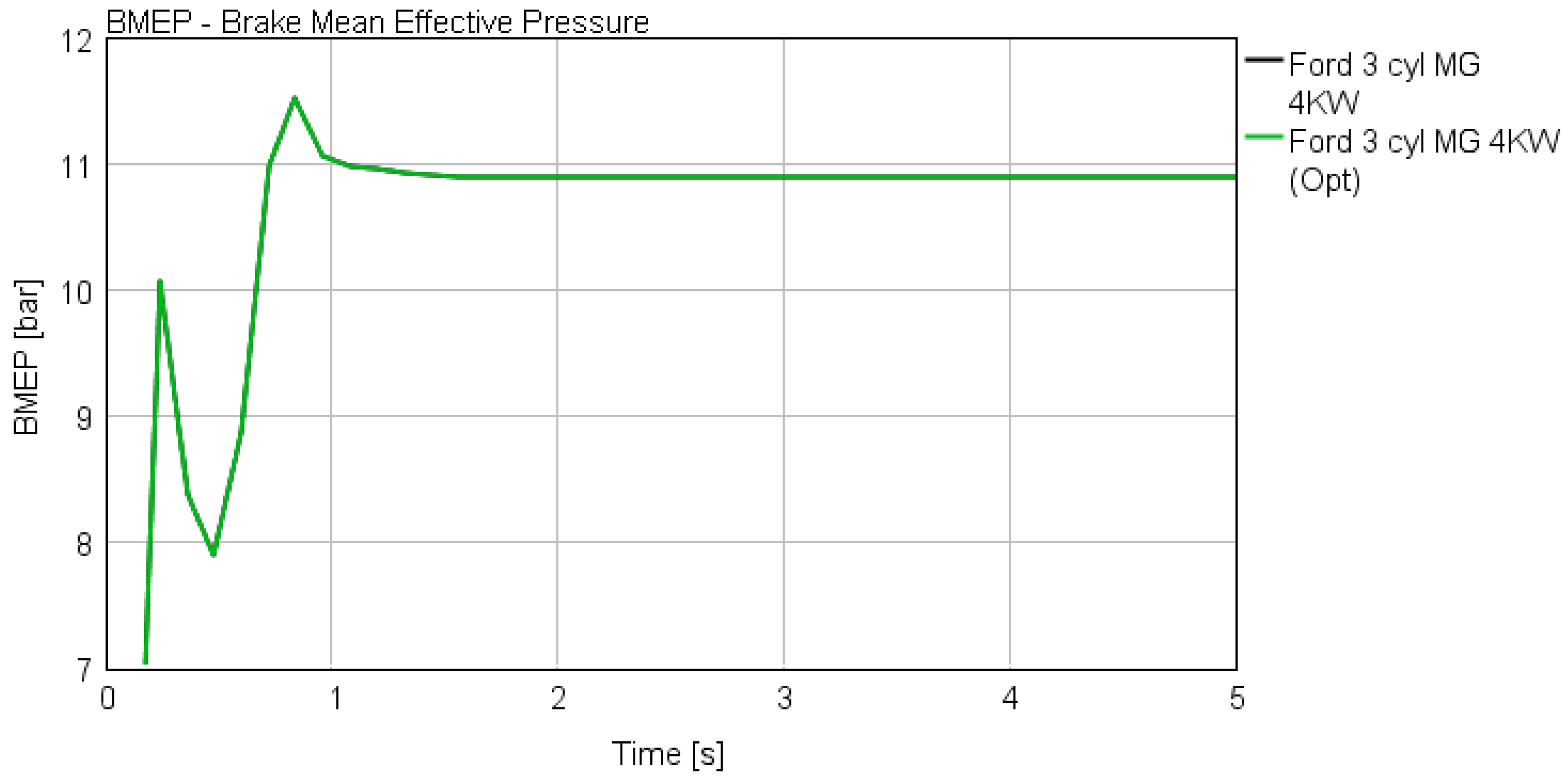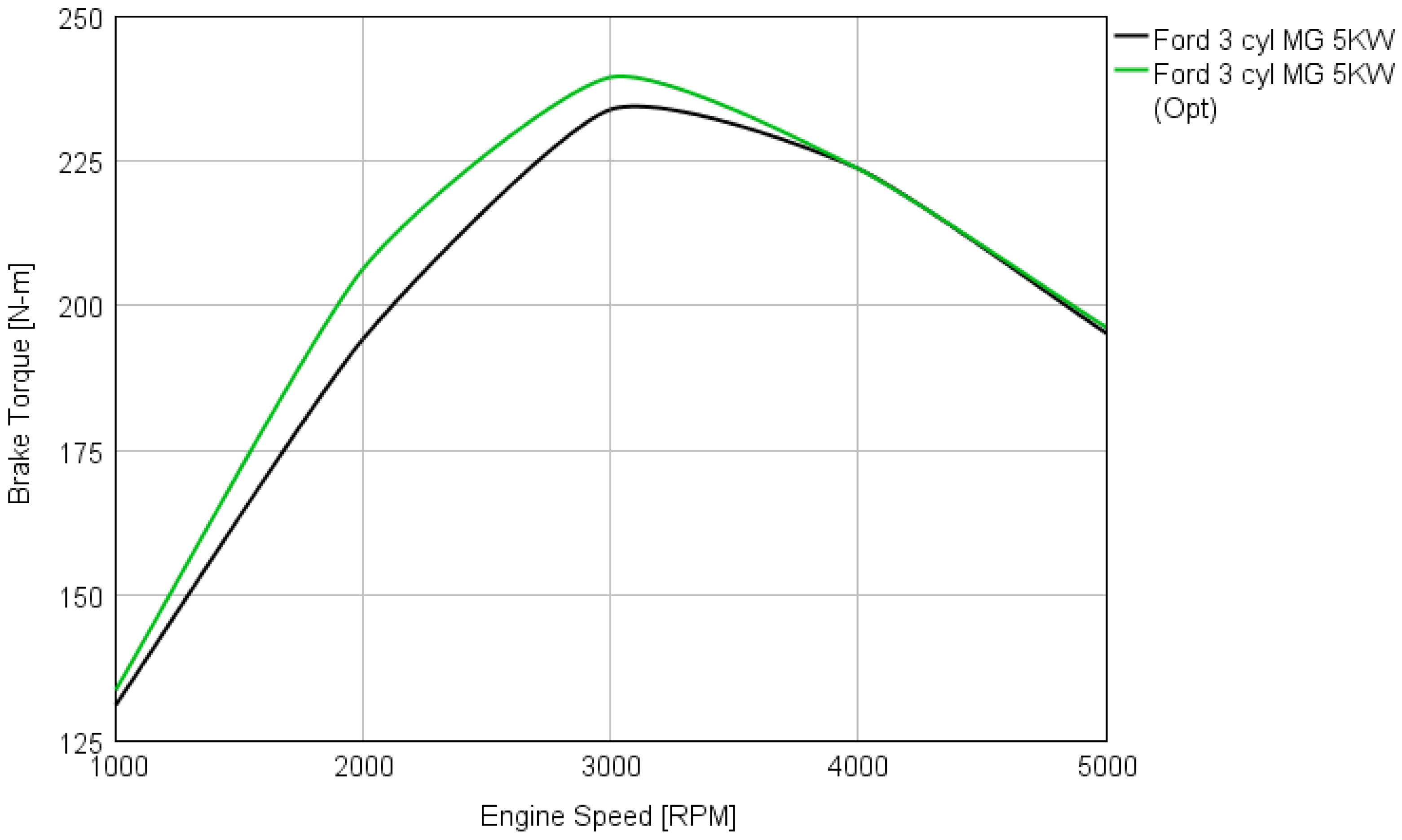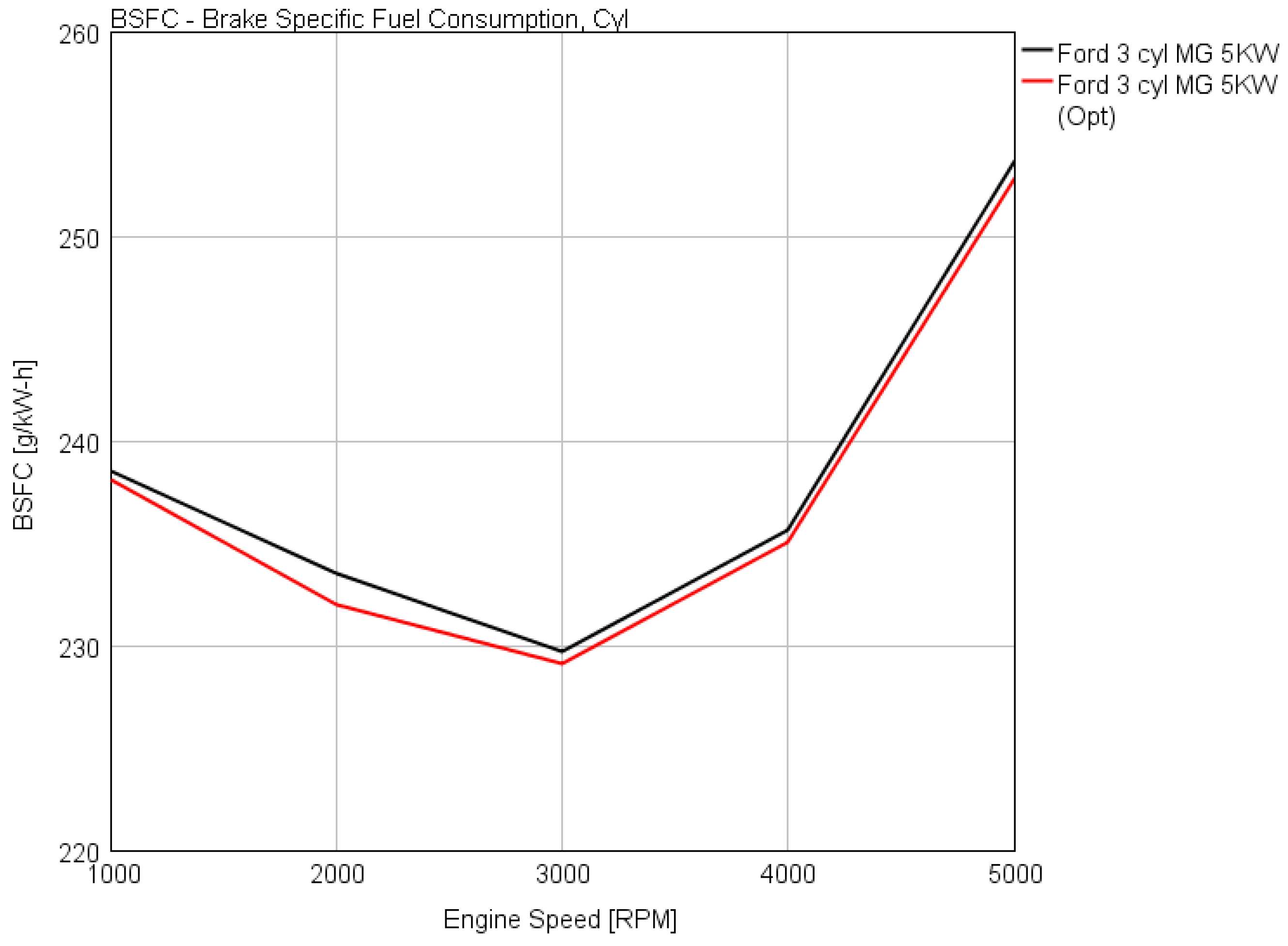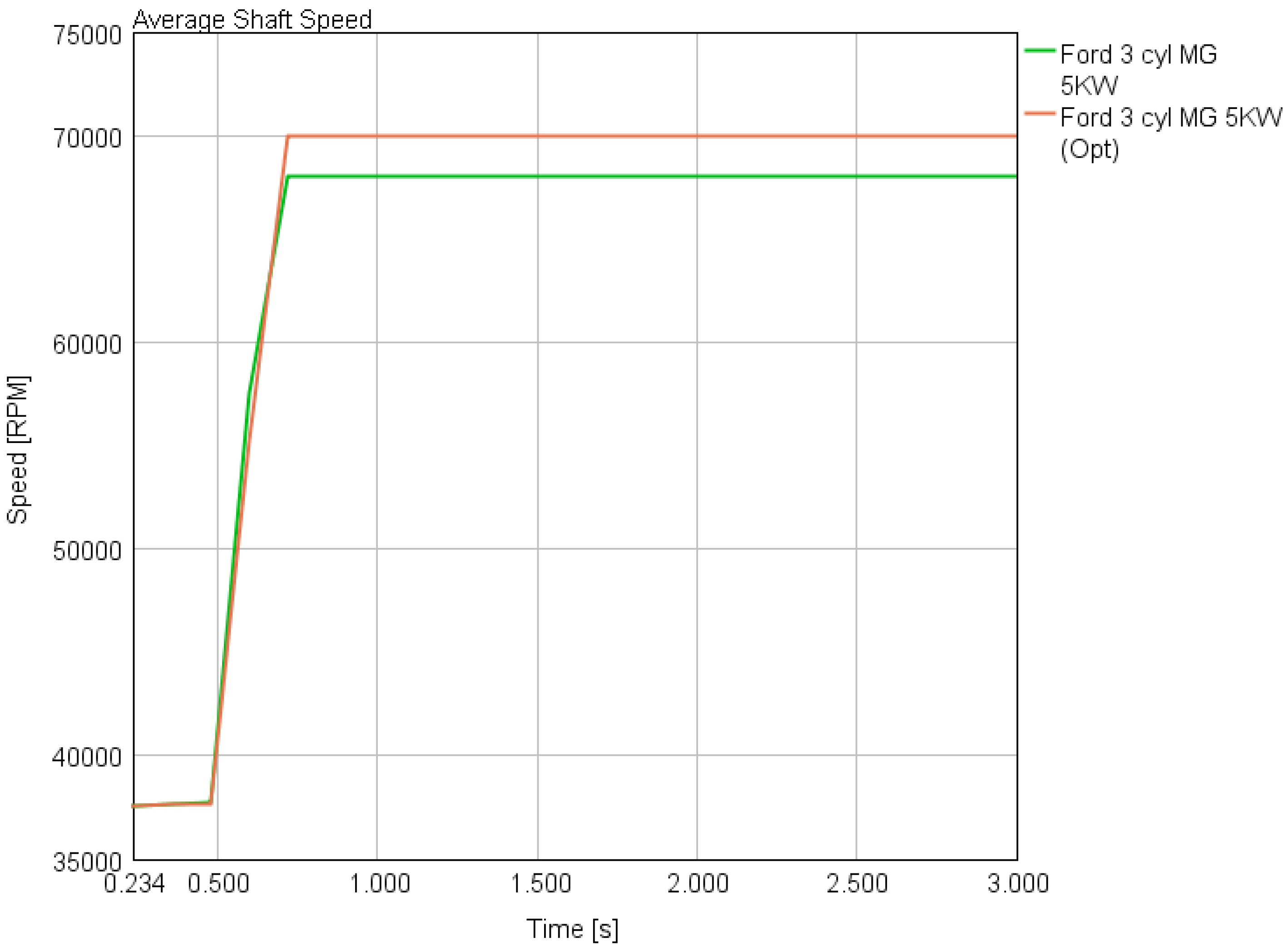1.1. General Turbocharging Advantages and Limitations
The impact of global warming has forced regulatory authorities around the world to establish strict regulations on CO
2 emissions and other greenhouse gas emissions. Although the regulations created several technical challenges for the automotive industry, this led to technology development since there was a demand of decreasing the fuel consumption of engines. This also led to increasing their performance because more power and more sustainable products had to be designed to reduce their environmental impact [
1,
2,
3]. Among various technologies that have been developed, the most effective way to increase the fuel economy and decrease the CO
2 emissions of passenger vehicles is engine downsizing [
4,
5]. The purpose of engine downsizing is the reduction of the throttling and friction losses associated with a larger engine by using a smaller, high power-density engine. Thus, engine efficiency is improved by operating in the more efficient regions, with the boosting device (turbocharger or supercharger) being the crucial component that allows this significantly increased power density to occur.
However, these conventional boosting devices have some limitations. Traditionally, the main drawback of the turbocharger is the delay in generating boost pressure, which results in insufficient torque at low engine speeds, known as turbo lag [
1,
6]. Conversely, the mechanical supercharger has a fast response at a low engine speed, but it creates parasitic losses to the engine since the required power for its operation is taken from the engine. One feasible solution for avoiding the drawbacks of the conventional boosting technologies is the electrification of the boosting system [
7,
8]. Electrification systems reduce the transient response (turbo lag) by 50% to 400% with respect to time-to-torque, which depend on the operating point of the turbocharger and engine. In addition, they can increase the overall engine efficiency for a substantial part of the turbocharged-engine operating range when compared to equivalent mechanical turbocharger systems [
9,
10]. Therefore, the aim of the paper is to model an advanced electric turbocharger compressor to improve the transient response of the turbocharger at low engine speed and, in turn, to enhance the performance, efficiency, and fuel economy of the engine.
1.3. Preliminary Design of Centrifugal Compressors
Yang et al. [
7] developed a radial compressor for an electric supercharger in a 2.0 L petrol engine by using a mean-line design process. In the process, the operating conditions of the compressor were provided and a set of geometrical parameters were selected to start the design. Then, computational fluid dynamics (CFD) simulation was applied in a detailed 3D design to analyze the compressor’s performance. The results of the computational fluid dynamics (CFD) simulation method showed a moderate reduction in total pressure ratio and total impeller efficiency when compared to the predicted corresponding values in the mean line method. However, it is worth noting that the scroll was excluded in the computational fluid dynamics (CFD) simulation. Hence, in this method, the predicted values of the total pressure ratio and total efficiency were slightly increased since the scroll loss was not included. Therefore, there is a significant difference in the results obtained from 1D modelling method and the computational fluid dynamics (CFD) simulation.
On the other hand, Harley et al. [
13] developed a novel mean line modelling method for radial compressors that is applied in automotive turbochargers. In this modelling approach, the pressure ratio and the recirculation flow of the compressor are linked. Furthermore, Harley et al. [
13] stated that the results obtained from the existing mean line methods would not be accurate in comparison with test data since the pressure ratio is predicted and, thus, it could rise and lead to surge. However, the new method deals with the issue by modelling the recirculation effects. Three different diameter centrifugal compressors with vane-less diffusers and scroll collectors were used for the process [
13]. The procedure starts with the analysis of the inlet blockage creation by recirculation flow and how this affects the induced flow into the impeller. The Galvas [
14] loss model collection was selected for the analysis. According to Harley et al. [
13,
15,
16], not only is it a robust model, but it also operates best across a variety of automotive turbocharger radial designs. Then, computational fluid dynamics (CFD) modelling was applied to verify all the results. The results indicate that, with the proposed mean line modelling process, the prediction methods are improved when the flow conditions are represented more accurately in the impeller. A major positive outcome of this study is that the novel method could be used for any centrifugal compressor to improve the blade angle selection when recirculation occurs.
For further validation and exposing the weakness of the novel mean line modelling method, another experiment was performed by Harley et al. [
7]. Although the modelling process was for the same variety of the turbocharger, automotive, the investigation was done on two new centrifugal compressors. For the purpose of this study, mean line modelling was used.
On the one hand, the results obtained from the single-zone modelling process were predicted accurately for the larger compressor at low-to-medium tip speeds. However, there was a slight difference in the prediction at the highest tip speeds. Moreover, the results obtained from the smaller compressor were not predicted accurately since the characteristic of the pressure ratio was insufficient toward the surge. As far as the single passage computational fluid dynamics (CFD) method is concerned, the results have shown that the inlet circulation can be predicted with high accuracy. However, the method is incapable of predicting the performance in the impeller trailing edge [
7].
In a recent paper by Samkit et al. [
17], the preliminary design of a centrifugal compressor was investigated using a non-dimensional method. The parameters’ dimensions were calculated by various equations and correlations such as Weisner, Lame Ovals equations, Rodger and Sapiro [
9], and Johnston and Dean [
18] correlations. Moreover, a 3D centrifugal compressor was designed to validate the results of the theoretical analysis. The analysis and simulations indicated that there was a slight difference, about 9% in the results between CFD and the theoretical method. Although the obtained results were in good agreement, the design losses were neglected from the theoretical calculations. Thus, the preliminary design procedure of the radial compressor is not accurate enough since the variation in the results would increase if the design losses were included.
Kerres et al. [
19] compared the performance of two types of 1D prediction models with numerical data for an automotive turbocharger centrifugal compressor with a vaneless diffuser and a scroll (
Figure 1). The prediction models used for the comparison were suggested by Aungier [
20] and Oh et al. [
21]. Moreover, the numerical results obtained by a 3D Reynolds-averaged Navier–Stokes (RANS) simulation for a small turbocharger compressor. The results of the comparison indicated that the 1D model were less accurate at low impeller speeds and choke than the computational fluid dynamics (CFD) 3D method. However, at high impeller speeds, they could predict precisely with a slight variation from the predictions of CFD calculations (see
Figure 1).
Furthermore, Kerres et al. [
19] found that the loss model by Aungier could predict with higher accuracy than the Oh et al. [
21] model. In addition, the results showed that the loss model collections could be improved, especially for jet-wake mixing and skin friction at high mass flows.
Moreover, an assessment of high-performance radial compressor parameters by 1D modelling and Reynolds-averaged Navier–Stokes (RANS) 3D computational fluid dynamics (CFD) simulation was done by Sundström et al. [
22]. A loss model and a steady state RANS model by Aungier [
23] were chosen for the 1D modelling and computational fluid dynamics (CFD) calculations, respectively. In addition, the centrifugal compressor examined was for automotive turbochargers, especially lightweight vehicles. The aim of the study was not only to quantify the variation between the predicted and the experimental data, but also to check the validation of the methodologies that were used.
Sundström et al. [
22] in
Figure 2 found that the 1D method generated accurate results at design conditions. However, at higher speed lines towards surge and choke, there was a significant variation in the results.
Figure 2 presents these variations at higher speed lines. N indicates the design speed of the compressor. Furthermore, the results for the validation of the used methodologies indicated that the impeller external loss was considerably higher in the computational fluid dynamics (CFD) calculations towards surge, but this loss could not be captured by the 1D model (see
Figure 3). Additionally, another significant difference was that the scroll loss was predicted to be larger in the 1D method. Lastly, the authors suggested that, by improving these major disparities in the 1D modelling method, it would be beneficial since the accuracy of the prediction method could be improved.
The present paper, therefore, is attempting to implement leading compressor preliminary performance zero-dimensional and pseudo one-dimensional techniques to the problem of implementation of these for turbocharger compressors, which are electrically assisted.


